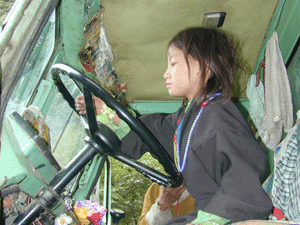THL Toolbox > THL Technologies & Open Standards > Technologies for Dummies > Introduction to THL Technologies
Introduction to Technologies Used by the Tibetan and Himalayan Digital Library
Contributor(s):

Young girl at wheel of land-rover (Barkham)
Please see the "technologies" menu tab above as well for links to the various components of this site:
Digital libraries such as THL are only possible through recent developments in computer technology. These new technologies provide the infrastructure and mechanisms necessary for an interactive repository of scholarly knowledge that has no corresponding analog in traditional libraries of printed material. Not only do such technologies allow for immediate interaction between the scholar and the collections of data, but they also permit collaboration between scholars separated by vast distances. While the casual user interacts with THL through the standard HTML web-pages, the active collaborator who is creating resources within THL will find it helpful to understand the Library's architecture in order to make the best use of the available tools for building collections and resources. The interested observer might also wish to know how a digital library actually works for their own reasons. The technologies section of the THL toolbox provides such information.
One of the principles of THL is the integration of different fields of study and types of resources into a single overarching repository. This repository is data-driven, containing a wide range of data in a variety of different formats, and it often is necessary to deliver specific data in two or more different formats depending on the user's needs. All this is achieved through the separation of data from the means of delivery and the gathering together of similar data types. The means for doing this is at the forefront of digital technology. THL is one of the first major implementations of an exciting new digital library initiative spearheaded by the University of Virginia and Cornell University to build a comprehensive and powerful digital library infrastructure based upon the FEDORA protocol ("Flexible Extensible Digital Object Repository Architecture"). It is through FEDORA that THL is able to truly achieve an interactive, extensible repository of information on Tibet and the Himalayan region.
One of the reasons digital libraries are possible is the development of an extensible mark-up language (XML), an updated version of the standard generalized mark-up language (SGML) on which the commonly used hypertext mark-up language (HTML) is based. XML and SGML are descriptive mark-up languages that provide information on the structure and content of the data rather than providing instructions on formatting its display, as HTML does. The difference between the two is that XML corrects some inconsistencies and ambiguities in SGML so that XML is truly eXtensible. By describing the data rather than its formatting and by being extensible, data marked up in XML can be easily transferred from one context to another without the need for burdensome conversion.
Since THL is an international digital library consisting of members and materials that use a variety of different scripts, including special "diacritic" marks in Roman scripts, the problem of fonts and their underlying encoding is a crucial issue. Computing and the Web has been bedeviled from the start by problems relating to multilingual computing, since there has been poor support for non-Roman scripts, or even special diacritic marks used with Roman script. As a result, much of the world and specialists have had to make due with poor solutions far removed from the easy use and convertibility we have come to expect from standard Roman script fonts. In THL, we face this most directly with Tibetan script, Devanagari for Nepali and other Indic languages, and diacritic marks used in Roman scripts to represent these languages. Unicode represents an exciting initiative that is establishing world side standards for every script in the world, with the promise of standardized computing support for each standard. While not completely implemented yet, Unicode is already transforming multilingual computing and we at THL have fully embraced it.
Because THL deals with a specific region of the world, geographical information is one of the prime components of the library. Data within THL is accessible through a thematic interface (e.g., collections on medicine, literature, music, etc.) and through a geographical interface based on specific locations (e.g., Lhasa, Dege, Amdo, Kham, the Tibetan Autonomous Region, and so forth). The geographical interface is based on a new technology known as GIS. GIS stands for "Geographic Information Systems", and refers to building spatial databases which provide latitude and longitude ("georeferencing") for every item within the databases. GIS software then allows one to query these databases, and then output the results in digital maps that combine various types of information. For example, one might query what temples are within five miles of lakes of over six square kilometers in size. The results could then be shown with blinking black dots against a backdrop of a digital map showing environmental land types, and administrative units.
Finally, THL is a non-profit venture providing services and resources to the general public worldwide. It is therefore our basic policy to use non-proprietary software whenever possible and to make all the tools created by the library freely available to the public under the THL Open Community License. While there are a variety of programming languages available, the one primarily used by THL is Java, because Java is uniquely suited for open-source projects. Java programs can also be run over the web as applets or servlets, and so it is the best programming language for a web-based project, such as THL. A majority of THL created tools are written in Java, though a few are created in Visual Basic for Applications (VBA) as MS Word templates.
h6 This page is provided courtesy of the  Tibetan and Himalayan Digital Library.
Tibetan and Himalayan Digital Library.